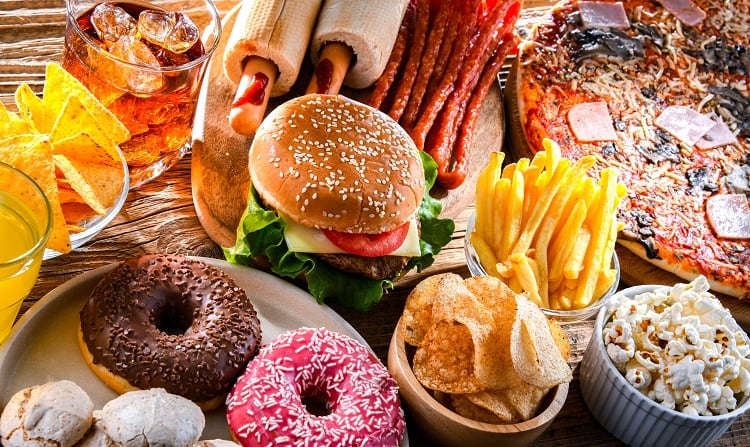Results from the largest study on ultra-processed food (UPF) to date have been published, and the news is not good for products in the Nova 4 category. According to study findings, UPF consumption is linked to a higher risk of adverse health outcomes, especially cardiometabolic, common mental disorder, and mortality outcomes.
Findings from the world’s largest UPF study to date
With close to ten million participants (mostly adults) included in the study, it is considered the world’s largest on ultra-processed food.
The research team, headed up by Melissa Lane, associate research fellow at Deakin University in Australia, gathered findings from existing reviews that combined results from multiple individual studies. The objective was to provide a comprehensive summary of the ‘strongest evidence available’ about how eating UPFs might be adversely associated with health.
The study responds to a growing UPF production and consumption trend. In high-income countries, research suggests the share of calories derived from UPF ranges from 42% and 58% in Australia and the US respectively, but much lower in Italy and South Korea (10% and 25% each). In low and middle income countries, these figures range from 16% in Colombia to 30% in Mexico.
What is ultra-processed food?
According to the Nova classification system, food and drink products considered ultra-processed are of ‘industrial creation’. Developed in Brazil in 2019, Nova splits level of processing into four classifications: from raw and minimally processed foods; to processed culinary ingredients; processed food; and ultra-processed foods.
The umbrella review found ‘convincing’ evidence linking UPF consumption to risks of developing cardiovascular disease related mortality, common mental disorder outcomes, and type 2 diabetes.
‘Highly suggestive’ evidence was identified between UPF consumption and risks of all cause mortality, heart disease related mortality, adverse sleep related outcomes, wheezing, obesity, and type 2 diabetes. ‘Suggestive’ evidence links UPF consumption to risks covering a range of conditions from risks of abdominal obesity to overweight, while ‘weak’ evidence was found for risks of developing colorectal cancer and overweight and obesity (combined).
Why might UPF consumption be linked to poor health outcomes?
This is the million-dollar question. Although more research is required to better understand mechanisms of action, one can speculate.
It could be that UPFs have poorer nutrient profiles, and/or by consuming UPFs, people eat fewer whole foods. It could also be that the physical processing element itself has a role to play: intensive processing may affect digestion, nutrient absorption, and feelings of satiety.
Many more potential explanations exist, but ultimately researchers continue their hunt for conclusive mechanisms of action.
Understanding exactly why UPF consumption has the potential to negatively impact health is even more important because research suggests not all UPFs impact health in the same way. Research published in The Lancet last year, for example, linked UPFs – but not bread or breakfast cereals – to multimorbidity.

Another recent study published in Diabetes Care found that UPFs including refined breads; sauces, spreads and condiments; artificially and sugar-sweetened beverages; animal-based products; and ready-to-eat mixed dishes were associated with higher type 2 diabetes risk. Conversely, cereals; dark and wholegrain breads; packaged sweet and savoury snacks; fruit-based products; and yoghurt and dairy-based desserts were associated with lower type 2 diabetes risk.
“These findings underscore the complexity of the relation between ultra-processed foods and adverse health,” noted Lane’s team. “Nevertheless, although some subcategories of ultra-processed items may have better nutrient and ingredient profiles, the overall consumption of ultra-processed foods remains consistently associated with a higher-risk of chronic diseases, as evidenced by our review.”
The researchers recommend ‘urgent’ mechanistic research and the development and evaluation of comprehensive population based and public health strategies, including government led policy frameworks and dietary guidelines aimed at targeting and reducing dietary exposure to UPFs for improved human health.
Where does lead author Melissa M Lane stand on the UPF debate?
Not all agree UPF should have a place in dietary guidelines, nor any place at all in the context of nutrition. It has also been argued that the Nova category is so broad (ranging from packaged bread to baked beans and fast food), that it’s unreasonable to judge all these foods in the same way.
Lead author Lane agrees that Nova classifies a broad array of foods and when classifying that as ultra-processed, does not focus on their nutrient content. Rather, it considers the extent, level and purpose of industrial food processing. “At this stage, Nova is an extremely important tool that is informing novel research efforts and policy,” she told FoodNavigator.
Further, many foods classified as UPF tend to be high in added sugar, fat and/or salt, and low in vitamins and fibre, and this poor nutrient profile is one valid and potential mechanism by which regularly eating higher compared to lower amounts of UPFs is linked to health outcomes.
“Although nutrients, especially those of concern like salt, sugar, and fat, will always be important, there's growing evidence that other aspects of UPFs, such as additives (e.g., emulsifiers and flavourings) and the way they're produced (e.g., using high temperatures and breaking down food particles), might also impact our biology in different ways,” Lane continued.
“We still need a lot more research, especially studies involving people, to fully grasp these connections. And the findings will likely vary depending on what health outcomes we're looking at and what types of foods we're comparing UPFs to.”
Nevertheless, Lane agrees with critics of Nova’s use in nutrition that looking at a person’s whole diet – rather than an individual food product – is what’s important. She even suggested combinations of different foods could interact in ways that might affect health outcomes over time.
“Therefore, when we examine how diet is linked to health, we need to take into account the variety of foods and beverages people consume. And what we found was people who regularly eat higher compared to lower amounts of UPFs, on the whole, have a higher relative risk of poor health.”
Ultra-processed food is ‘very tempting to buy’
One case against ultra-processed food (that was recently made publicly by author of the UK’s National Food Strategy Henry Dimbleby and medical doctor and author Chris van Tulleken) is that UPF manufacturers are selling these products with over-consumption and profit front-of-mind.
To this, Lane responded that methods and increased to used to make UPFs are about making them taste good and have a long shelf-life. “This, at face value, isn’t necessarily a bad thing, but it makes them very tempting to buy.”

UPFs are also ‘everywhere’ because they are convenience, cheap and heavily advertised, she continued. “We know that a lot of time, efforts and money goes into figuring out what textures, components and combinations of ingredients are most compelling to us.
“Regardless of industry intentions, these foods have become a major part of our diet – people love them and buy them to the exclusions of others, and the end result is that high UPF diets are associated with many poor health outcomes.”
Source: The British Medical Journal (BMJ)
‘Ultra-processed food exposure and adverse health outcomes: umbrella review of epidemiological meta-analyses’
Published 28 February 2024
DOI: https://doi.org/10.1136/bmj-2023-077310
Authors: Melissa M Lane, Elizabeth Gamage, Wolfgang Marx et al.




